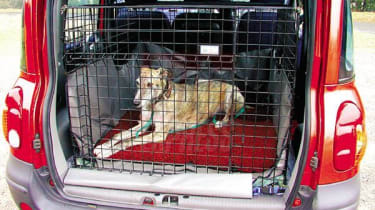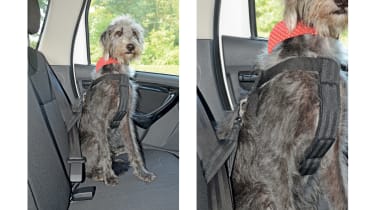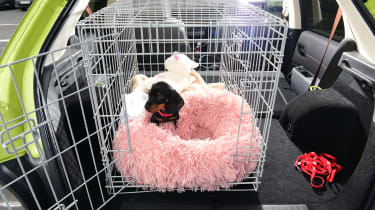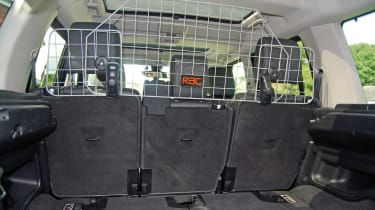If you plan to carry your dog in the car, the law is pretty straightforward. Rule 57 of the Highway Code states that you must “make sure dogs or other animals are suitably restrained” in a vehicle. So, you can’t have Bonzo wandering around the car’s cabin or sticking his head out of the window as he sees fit.
This rule is in place to protect you, your dog and other road users. Imagine if your dog were to suddenly jump onto your lap after seeing something enticing out of the driver’s side window? You run the risk of a crash, and possibly injuring yourself, your canine companion or another road user.
If that crash were severe enough to activate your car’s airbags, there’s a good chance these could injure or even kill your dog. And on top of that, you’ll be liable for at least a hefty fine. For these reasons, a proper dog restraint is essential whenever you carry a dog in your car.
How to restrain your dog in the car: tips and safety products
Food and drink
Preparation is key to making your dog as comfortable and relaxed as possible during a car journey, because they’re going to be restrained and might not be entirely happy about it.
So, try not to feed the dog less than two hours before you hit the road, because it could induce car sickness. However, it is worthwhile making sure your dog isn’t thirsty beforehand, because this could also induce illness.
And make sure that you have a large bottle of water with you, so that you can quickly give your dog a drink should it become dehydrated.
Dog crates

A dog crate is the safest and most comfortable way to transport your beloved hound in the car. And if your dog is already acclimatised to a large crate through in-house training, this will also be one of the least stressful ways to transport it.
A good crate offers a dog a decent amount of space to sit or lie down in. They tend to be made of either plastic or plastic-covered metal mesh, and they offer dogs plenty of fresh air and the ability to still feel part of the goings-on farther forward.
Some crates also allow you to carry more than one dog at once, and the companionship will help to keep everyone calm.
And should the worst happen, and you have an accident, a crate will stop the dog being violently thrown around the cabin.
Dog harnesses

If a dog crate doesn’t work for you or your pet, a dog car harness is another option. In essence, this is a harness that fits around your dog, and which can then be clipped to a rear-seat seatbelt. If you want to clip it to the seatbelt on the front passenger seat, you’ll first need to disable the passenger airbag, because this could do your dog serious harm in a crash.
There are harnesses to fit all sizes of dog, and they should be multi-adjustable. Good ones will also have a grab handle to allow you to more easily control your dog when putting it into the vehicle or manoeuvring it into position on the seat.
And if you’re worried about the condition of the rear seat, there are plenty of robust pet blankets that can be put down to protect your car’s upholstery.
A harness also means that anyone sitting on the back seat alongside the dog can help to keep it calm with attention, strokes and treats.
Pet carriers

A pet carrier is a good idea if you have a smaller breed of dog, because it’s smaller than a dog crate and allows you to simply carry your dog to the car and place it into the boot area. Your dog may not have a huge amount of space to stretch out but a carrier can make a space-efficient way to transport your canine, as long as the journey isn’t too lengthy.
In addition, there’s also the convenience factor brought about by the fact that your dog is already in its ‘transportation suite’ before it even gets to the car.
A pet carrier is designed to be easier to move around, and is designed to be slightly more compact and to remain closed throughout the journey, so that your dog can’t move around too much. There are, again, safety benefits to this because if anything untoward happens then your dog won’t be bounced around, minimising the chances of injury.
Boot guard

Some dogs simply prefer to sit in the car’s boot, and if that applies to your pet then you would be wise to fit a guard between the back seat and the boot area to stop your dog from being able to leap over the back seat and into the cabin area.
Nevertheless, it is safest for everyone concerned if you combine the use of the dog guard with a dog car harness or a dog car crate, to minimise the amount they’ll be moved around in an accident. Better still, you can combine the dog guard with a boot divider, which splits the boot area in half lengthways. This will not only keep your dog contained in one half, but also allows you to use the other half of the boot for shopping and luggage.
Planning on a driving adventure? Read our guide on the best cars for outdoor pursuits

